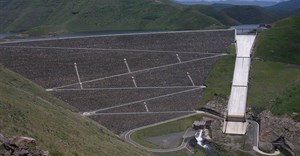
Subscribe & Follow
The devastating impact of acid mine drainage

The pH level of the water was dangerously acidic at 3.7 and the concentrations of iron, aluminium, manganese and sulphate were above acceptable limits. The standard chlorination and sediment removal treatments were proving inadequate to solve the problem. The Boesmanspruit Dam, which supplies the town’s water, had also turned dark green in colour and fish in the spruit and dam were dying.
After much investigation, the probable cause was determined: acid mine drainage (AMD) from coal mining activity in the area. The town was without piped water for seven months.
Impact on the water supply
Terence McCarthy, emeritus professor of mineral geochemistry in the School of Geosciences, and Dr Marc Humphries, an environmental geochemist in the School of Chemistry at Wits were part of the team that investigated the Carolina disaster. McCarthy believes AMD could be the cause of a future catastrophe in South Africa and, while Carolina was a stark and sudden example of the devastating effects of AMD on the environment, it is not the only case. AMD is happening everywhere there is mining activity – albeit slowly.
“The water in the Middelburg Dam is already undrinkable and I believe that the Grootdraai Dam near Standerton, which is in the Vaal River system, could follow suit,” says McCarthy.
The Vaal River supplies not only Gauteng but also many towns downsteam, including Bloemhof, Welkom, Kimberley and Postmasburg. The major culprits are the coal and gold mines, and because of their location in the upper portions of the Vaal River catchment, their footprint on the water supply is huge.
Aside from metal and acid pollution, the major problem is the increase in dissolved salts into the Vaal River. In order to keep the salt load at tolerable levels, the Department of Water and Sanitation is obliged to release water from upstream dams into the Vaal system to dilute the pollution, thereby effectively wasting water.
Solutions
AMD occurs when water reacts with pyrite (‘fool’s gold’) in mining cavities beneath the earth’s surface. The water becomes acidic and rich in iron, lead and other heavy metals – a combination that is toxic to living organisms. This water then joins the ground water system, sterilises the soil, and eventually flows into streams and rivers where it could join the drinking water supply system. Currently, plans and methods to tackle the problem are woefully inadequate and those that work cost a fortune.
Reverse osmosis is already in use at the eMalahleni Treatment Plant in Mpumalanga. The end-product, however, costs five times the price of natural water, because of the extensive energy used in the process, says McCarthy.
“Currently, the standard treatment for AMD is to aerate the water to oxidise the iron and add lime to bring the pH up. The iron then precipitates out – and most heavy metals along with it – in a deep red colour. After that settles, the waste is dumped on old mine dumps – the reason some will have red tops.” However, the water still has high sulphate content. “Although it’s not particularly poisonous, it’s above the World Health Organisation’s recommended limit and so remains undrinkable,” says McCarthy.
Another option is to dilute or flush the water using water from clean systems (the eventual solution at Carolina) but this is a massive waste of a precious commodity in a dry country like South Africa. Similarly, wetlands act as natural purifiers, but flushing large quantities of polluted water through these systems destroys them.
Khuliso Masindi, a PhD student in hydrogeology at Wits encountered AMD in the Witwatersrand area while monitoring ground water in 2012. “The water would be orange or yellow because of the oxidation of sulphites from the mines, and would have a pH of 2 or 3, and that then flowed into streams. Methods can be used to limit AMD at new mines, but the old tunnels always remain,” says Masindi, who believes the AMD problem is virtually insurmountable.
And despite the substantial rainfall in Gauteng and Mpumalanga in the last few years, which helped flush the problem, McCarthy fears dark days lie ahead: “The problem will intensify when that (rainfall) changes. The next drought will be trouble.”













